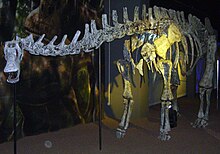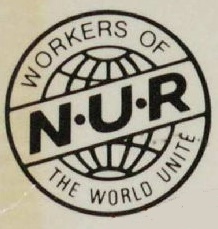힌쿨 지층
Huincul Formation| 힌쿨 지층 | |
|---|---|
| 지층 범위:후기 세노마니아-초기 투로니아 ~ Pre ꞓ ꞓ ↓ | |
| 유형 | 지질학적 형성 |
| 단위 | 노이켄 그룹 리오 리메이 군 |
| 언더리스 | 리산드로 지층 |
| 오버리스 | 칸델레로스 지층 |
| 두께 | 250m (820ft) |
| 암석학 | |
| 기본적인 | 사암 |
| 다른. | 클레이스톤 |
| 위치 | |
| 좌표 | 39°24'S 69°00'W/39.4°S 69.0°W |
| 대략적인 고좌표 | 46°06'S 46°00'W/46.1°S 46.0°W |
| 지역 | 멘도사 주, 리오네그로 주 |
| 나라 | 아르헨티나 |
| 정도 | 노이켄 분지 |
| 유형구간 | |
| 이름: | 휘인쿨 광장 |
| 이름: | 케이델 |
| 정의년도 | 1929 |
후인쿨 지층(Huincul Formation)은 아르헨티나 파타고니아 북부의 멘도사 주, 리오 니그로 주, 노이켄 주에 분포하는 노이켄 분지의 백악기 후기(세노마니아 초기~투로니아 후기)의 지질 지층입니다.[1]리오 리메이 서브그룹의 두 번째 지층으로, 뇌켄 그룹 내에서 가장 오래된 서브그룹입니다.이전에 그 하위 그룹은 포메이션으로 취급되었고, 후인쿨 포메이션은 후인쿨 멤버로 알려졌습니다.[2]
묘사
힌쿨 층의 유형 지역은 노이켄 지방의 힌쿨 광장 마을 근처이며, 1929년 위히만에 의해 힌쿨 층의 이름이 지어졌습니다.[3]이 층은 칸델레로스 층 위에 적합하게 놓여 있고, 리산드로 층 위에 차례로 놓여 있습니다.
힌쿨 층은 일시적이거나 계절적인 개울이 있는 건조한 환경을 나타내는 것으로 여겨집니다.[4]어떤 지역에서는 두께가 250미터에 이릅니다.주로 녹색과 노란색 사암으로 구성되어 있으며, 붉은색을 띠는 위의 리산드로 지층과 쉽게 구분할 수 있습니다.캉델레로스 지층은 힌쿨의 기초가 되는 어두운 퇴적물로 구성되어 있어 세 지층 모두 쉽게 구분할 수 있습니다.[2][5]
화석함량

화석 뼈는 종종 힌쿨 층에서 발견됩니다.그러나, 알려진 가장 큰 육지 동물 중 하나인 아르젠티노사우루스 힌쿨렌시스의 유해가 힌쿨 층에서 발견되었고, 이 종은 그것의 이름을 따서 지어졌습니다.[2]알려진 가장 큰 육상 포식자 중 하나인 마푸사우루스 또한 이 형태의 뼈층에서 발견되었습니다.[4]
공룡들

힌쿨 층에서 발견된 화석은 공룡의 화석을 포함합니다.
- 아르젠티노사우루스, 초콘사우루스, 추카로사우루스[6] 등 여러 티타노사우루스류 용각류
- 렙바키사우루스과 용각류 (카타르테사우라와 리메이사우루스 포함)
- 카르카로돈토사우루스과 수각류 (마푸사우루스[7], 메락시스[8], 타우로베네토르[9] 포함)
- 수각류(Gualico)로 추정되는 신식각류
- 거대한 수각류 (아오니랍토르)
- 몇몇 아벨리사우루스과 수각류 (스코르피오베네토르, 트랄카사우루스, 일로켈레시아 포함)
- 여러 [10]이구아노돈트와 조류
- 아벨리사우루스과와 하드로사우루스과의[11] 이크노 화석
- 용각류
| 사우리시아인 | ||||
|---|---|---|---|---|
| 용각류 | ||||
| 탁사 | 종. | 재료. | 메모들 | 이미지들 |
| 아르젠티노사우루스 | 후인쿨렌시스 | 후두골유골 | 티타노사우루스의 용각류입니다. |  |
| 카타르테사우라 | 다. 혐기성의[12] | 렙바키사우리드 | ||
| 초콘사우루스 | C. 베일리 윌리시[13] | 티타노사우루스의 용각류입니다. |  | |
| 추카로사우루스 | 다. 디리피엔다 | 완전한 왼쪽 상완골, 부분 왼쪽 반지름, 완전한 왼쪽 중완골 II, 왼쪽 좌골반골, 부분 왼쪽 대퇴골 및 섬유, 부분 오른쪽 경골 및 부분 미결정 메타포디얼.[6] | 티타노사우루스의 용각류입니다. |  |
| 리메이사우루스 | L. 테소니 | 렙바키사우리드 |  | |
- 수각류
| 사우리시아인 | ||||
|---|---|---|---|---|
| 수각류 | ||||
| 탁사 | 종. | 재료. | 메모들 | 이미지들 |
| 아오니랩터 | A. liberataem | 천골 척추, 6개의 근위 미족 척추, 4개의 미족 척추.[14] | 메가랍토란 수각류. | |
| 구알리초 | G. 신애 | 신식공이 수각류를 지배했습니다. |  | |
| 후인쿨사우루스 | H. 몬테시 | 척추뼈[15] 여러 개의 척추뼈 | 노아사우리드공룡 |  |
| 일로켈레시아 | I. 아과다그란덴시스 | 아벨류는 수각류 동물입니다. |  | |
| 마푸사우루스[16] | 장미대 | 카르카로돈토사우루스과 수각류 |  | |
| 메락시스 | M. 기가스[8] | 카르카로돈토사우루스과 수각류 |  | |
| 오버랩터 | O. 치멘토이[17] | 파라비아 수각류. |  | |
| 스코피오베네이터 | S. 빵터짐 도리이 | 아벨리사우루스과 수각류 |  | |
| 타우로베네이터[9] | T. 비올란티[18] | 카르카로돈토사우루스과 수각류 | ||
| 트랄카사우루스 | 티쿠이 | 아벨류는 수각류 동물입니다. | ||
참고 항목
참고문헌
- ^ Huincul Formation Fossilworks.org
- ^ a b c 산체스 외, 2006
- ^ 위치만, 1929
- ^ a b 코리아 & 커리, 2006
- ^ Leanza et al., 2004, p.68
- ^ a b Agnolin, Federico L.; Gonzalez Riga, Bernardo J.; Aranciaga Rolando, Alexis M.; Rozadilla, Sebastián; Motta, Matías J.; Chimento, Nicolás R.; Novas, Fernando E. (2023-02-02). "A new giant titanosaur (Dinosauria, Sauropoda) from the Upper Cretaceous of Northwestern Patagonia, Argentina". Cretaceous Research: 105487. doi:10.1016/j.cretres.2023.105487. ISSN 0195-6671.
- ^ Canale et al., 2012
- ^ a b Canale, J.I.; Apesteguía, S.; Gallina, P.A.; Mitchell, J.; Smith, N.D.; Cullen, T.M.; Shinya, A.; Haluza, A.; Gianechini, F.A.; Makovicky, P.J. (2022). "New giant carnivorous dinosaur reveals convergent evolutionary trends in theropod arm reduction". Current Biology. doi:10.1016/j.cub.2022.05.057.
- ^ a b Motta, Matías J.; Aranciaga Rolando, Alexis M.; Rozadilla, Sebastián; Agnolín, Federico E.; Chimento, Nicolás R.; Egli, Federico Brissón; Novas, Fernando E. (June 2016). "New theropod fauna from the Upper Cretaceous (Huincul Formation) of northwestern Patagonia, Argentina". New Mexico Museum of Natural History and Science Bulletin. 71: 231–253 – via ResearchGate.
- ^ 카누도, J. I., 살가도, L., 가리도, A., 카르발리도, J. L., 아라고사우루스-IUCA, G., 로보, I., Negro, R., & Olsacher, J. A. (2013).Primera revidencia de dinosaurios ornitópodos en la base de la Formación Huincul (Cenomaniense Superior-Turoniense, Cuenca Neuquina, 아르헨티나) Huincul 형성의 기저부(Cenomanian - Upper Turonian, Neuquen Basin, 아르헨티나)에서 조류 공룡에 대한 최초의 증거.
- ^ 레오나르디, 1994, p.30
- ^ Gallina, Pablo A.; Apesteguía, Sebastián (2005). "Cathartesaura anaerobica gen. et sp. nov.,a new rebbachisaurid (Dinosauria, Sauropoda) from the Huincul Formation (Upper Cretaceous), Rio Negro, Argentina". Revista del Museo Argentino de Ciencias Naturales. Nueva Series. 7 (2): 153–166. doi:10.22179/REVMACN.7.332.
- ^ Simón, Edith; Salgado, Leonardo; Calvo, Jorge O. (2017). "A new titanosaur sauropod from the Upper Cretaceous of Patagonia, Neuquén Province, Argentina". Ameghiniana. 55: 1–29. Retrieved 2020-03-16. Doi:10.5710/AMGH.01.08.2017.3051
- ^ Motta, Matías J.; Aranciaga Rolando, Alexis M.; Rozadilla, Sebastián; Agnolín, Federico E.; Chimento, Nicolás R.; Egli, Federico Brissón; Novas, Fernando E. (June 2016). "New theropod fauna from the Upper Cretaceous (Huincul Formation) of northwestern Patagonia, Argentina". New Mexico Museum of Natural History and Science Bulletin. 71: 231–253 – via ResearchGate.
- ^ Mattia Baiano; Rodolfo Coria; Andrea Cau (2020). "A new abelisauroid (Dinosauria: Theropoda) from the Huincul formation (lower upper Cretaceous, Neuquén Basin) of Patagonia, Argentina". Cretaceous Research. doi:10.1016/j.cretres.2020.104408.
- ^ Canale et al., 2012
- ^ Matías J. Motta; Federico L. Agnolín; Federico Brissón Egli; Fernando E. Novas (2020). "New theropod dinosaur from the Upper Cretaceous of Patagonia sheds light on the paravian radiation in Gondwana". The Science of Nature. 107 (3): Article number 24. Bibcode:2020SciNa.107...24M. doi:10.1007/s00114-020-01682-1. hdl:11336/135530. PMID 32468191. S2CID 218913199.
- ^ Motta, Matías J.; Aranciaga Rolando, Alexis M.; Rozadilla, Sebastián; Agnolín, Federico E.; Chimento, Nicolás R.; Egli, Federico Brissón; Novas, Fernando E. (June 2016). "New theropod fauna from the Upper Cretaceous (Huincul Formation) of northwestern Patagonia, Argentina". New Mexico Museum of Natural History and Science Bulletin. 71: 231–253 – via ResearchGate.
서지학
- Canale, Juan Ignacio; Apesteguía, Sebastián; Makovicky, Peter; Gallina, Pablo Ariel; Gianechini, Federico; Smith, Natan; Maniel, Ignacio; Haluza, Alejandro (2012). "New carcharodontosaurid theropod remains from El Chocón Neuquén Group, Huincul Formation, Neuquén, Argentina". Ameghiniana. 50.
- Coria, R.A.; Currie, P.J. (2006). "A new carcharodontosaurid (Dinosauria, Theropoda) from the Upper Cretaceous of Argentina". Geodiversitas. 28: 71–118. Retrieved 2019-02-16.
- Leanza, H.A.; Apesteguia, S.; Novas, F.E.; De la Fuente, M.S. (2004). "Cretaceous terrestrial beds from the Neuquén Basin (Argentina) and their tetrapod assemblages". Cretaceous Research. 25: 61–87. Retrieved 2019-02-16.
- Leonardi, Giuseppe (1994). "Annotated Atlas of South America Tetrapod Footprints (Devonian to Holocene) with an appendix on Mexico and Central America". Ministerio de Minas e Energia - Companhia de Pesquisa de Recursos Minerais, Geological Service of Brazil. pp. 1–248. Retrieved 2019-03-25.
- Sánchez, María Lidia; Heredia, Susana; Calvo, Jorge O. (2006). "Paleoambientes sedimentarios del Cretácico Superior de la Formación Plottier (Grupo Neuquén), Departamento Confluencia, Neuquén" [Sedimentary paleoenvironments in the Upper Cretaceous Plottier Formation (Neuquen Group), Confluencia, Neuquén)]. Revista de la Asociación Geológica Argentina. pp. 3–18. Retrieved 2019-02-16.
- Wichmann, R (1929). "Los Estratos con Dinosaurios y su techo en el este del Territorio del Neuquén ("The dinosaur-bearing strata and their upper limit in eastern Neuquén Territory")". Dirección General de Geología, Minería e Hidrogeología Publicación. 32: 1–9.



